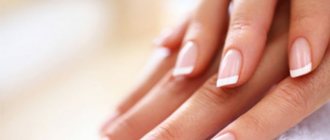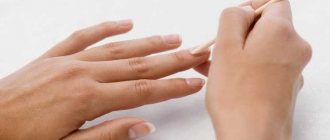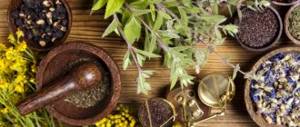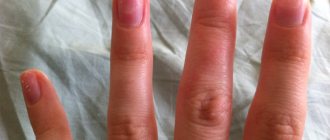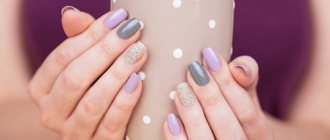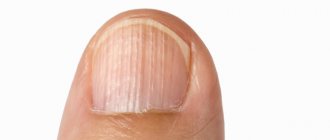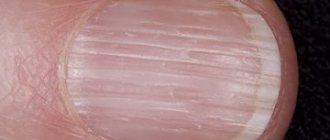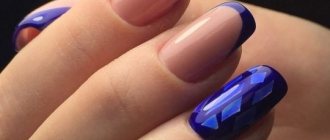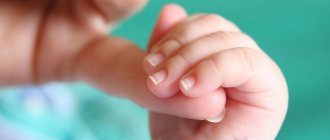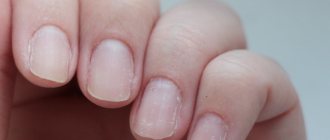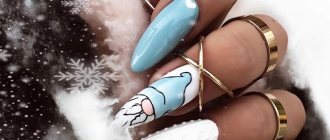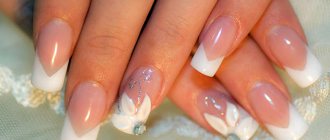Pseudomonas aeruginosa, green mold, pseudomonia. A nightmare for every master and client. What is this? Pseudomonia is a nail disease caused by pseudomonas (bacteria). They develop under artificial material, i.e. in a space where there is no oxygen, it is humid and there is a source of nutrition - the cells of the natural nail.
The disease manifests itself as a color change from green to gray-black. It is asymptomatic, odorless and does not cause pain. And this is its main danger. It doesn't hurt, which means it's not dangerous. This is a big misconception.
Color is the waste products of bacteria; they themselves are invisible. As the disease progresses, the nail is gradually destroyed and a moment inevitably comes (if the disease is not treated) when the pathogen enters the bloodstream through the nail bed. The result is blood poisoning and sepsis.
Bacteria multiply and develop at an enormous rate, so it only takes a few days for the disease to develop.
An unattractive prospect, you will agree.
Why do fingernails turn green?
There are several reasons why a nail may turn green, greenish-blue, or brownish-green. Let's look at the most common ones:
From microtraumas and bruises, drops of blood can collect under the nail plate, which, as the bruised area heals, changes color from red to blue, greenish and yellow. If this is precisely the reason for the discoloration on the client’s nails, it is worth waiting until the plate acquires a uniform, healthy shade without visible signs of inflammation. For deep bruises, you should wait until the area has completely grown back, or consult a dermatologist to remove blood from under the plate. Only after this can long-term coating be applied and extensions carried out. Otherwise, inflammation and peeling of the nails are possible.
- Yeast-like fungi Candida
A fungal infection that causes the plates to turn green or greenish is treated with external medications. The causes of fungal infection are failure to comply with hygiene rules at home and in public places. Nails affected by fungus are a favorable environment for the development of other infections. Treatment - antifungal creams and ointments, vinegar, oral tablets. At this time, it is better to refuse to cover the affected nails with varnish and extension materials, so as not to aggravate the situation, especially if the first symptoms of peeling appear.
- Fungi of the genus Aspergillus
The proliferation of this fungus on the surface of the plates can also cause the nails to turn green
That is why, before starting any treatment for a fungal disease, it is important to determine the group of the fungus in order to select a drug and not waste time and money on ineffective remedies. If only the plate is affected, the disease can be treated externally
Depending on the degree of damage, medications are prescribed by a dermatologist.
- Bacterial infection caused by the bacterium Pseudomonas Aeruginosa
Translated into Russian, this is Pseudomonas aeruginosa. A very dangerous infectious agent, the waste product of which is a green pigment that stains the nail. Pseudomonia lives freely in the external environment and is considered conditionally pathogenic. Without a humid environment, a temperature of 36-37 degrees and a weakened immune system, it rarely provokes disease. When Pseudomonas aeruginosa enters the body, it causes very serious infections with deep damage to the skin, blood, and internal organs. Treated with antibiotics.
When diagnosing pseudomonia on the surface of the nail and painting the plate green without penetrating into the soft layers, this is not so dangerous, but unpleasant. Amenable to antiseptic and disinfectant treatment using an acid primer, citric or acetic acid. The infected area is first filed down until the green spot is eliminated. There is no need to take antibiotics if only the surface of the plate is affected without penetration into the soft layers.
Pseudomonia is the cause of green nail syndrome. It is about this, as well as about ways to eliminate the problem in the cabin, that we will discuss further.
Causes
In 60% of cases, onycholysis develops after a blow, from injury, or when a nail is pinched. Moreover, even a minor injury is enough that a person will not pay attention to. The second most common cause of nail onycholysis is fungal infection (onychomycosis). The disease is also caused by allergies. For example, when hands come into contact with household chemicals.
Depending on the cause, the nail may be affected only on one finger or on several fingers at the same time.
The risk group includes people who have:
- chronic skin diseases (eczema, psoriasis);
- malnutrition, deficiency of vitamins A, E, group B;
- metabolic disorders;
- predisposition to allergic reactions;
- weakened immunity, including during pregnancy and old age;
- diabetes.
The disease onycholysis often appears in workers in the chemical industry and laboratories, whose hands are constantly in contact with organic solvents and aggressive substances.
Due to the desire for beauty, women face this problem more often than men.
Onycholysis is caused by:
- nail extensions;
- improper performance of manicure or pedicure;
- injury to the cuticle area;
- the use of decorative varnishes, liquids for their removal containing harmful organic solvents;
- gel polish coating.
Almost all women like to do the procedures listed above to make their hands look attractive and well-groomed. But the first thing to remember is safety. Because many of them do not have the most favorable effect on nails. Cause allergic reactions, chemical burns, burns from an ultraviolet lamp.
Often onycholysis occurs on the hands from gel polish or shellac. Why is this happening? The reason is ignoring precautions. When drying under a UV lamp, the nail burns. Therefore, if the master says, take it out, if he bakes, you need to do it. If you tolerate the burning sensation for a couple of minutes, the consequences can be dire. You risk being left not only without a manicure, but also without nails. The burning sensation provokes a burn, a disruption of the connection between the plate and the nail bed. Therefore, you need to take your hands out from under the lamp for a few seconds until the discomfort disappears.
In addition to the above reasons, the disease is caused by long-term use of medications that increase the body's sensitivity to solar radiation. We are talking about antibiotics from the group of penicillin and tetracycline. For example, in the instructions for the drug Doxycycline, the list of adverse reactions states that it can cause photoonycholysis, a change in the color of nails.
The causes of onycholysis on the arms and legs are different. Toenails are less likely to undergo aesthetic manicure procedures, but are more often injured. Most often, detachment of the nail plate occurs on the big toe due to mechanical compression from tight closed shoes, flat feet, improper distribution of the load on the foot, disruption of its biomechanics, and long nail length.
Possible complications
The mold that forms on the nails after extensions can affect the entire plate within two weeks. The finger gradually turns red, swells and becomes painful. There is a risk of infection spreading to soft tissues and infection of the entire body.
Fortunately, such advanced cases are the exception. Most often, a woman seeks help as soon as she notices a green spot on her nail. At the initial stage, getting rid of Pseudomonas aeruginosa is not difficult.
How to distinguish mold from pseudomonia
It is not uncommon to hear about pseudomonas (pseudomonas aeruginosa), another problem that can appear on the nails. Out of ignorance, pseudomonia is confused with mold fungi, since they give exactly the same symptoms. What's the difference?
Mold under the nails is a type of fungal infection that begins with skin lesions. The spores then spread to the nail plates, gradually worsening the situation.
Pseudomonias are gram-negative bacteria that live on a variety of surfaces. In small quantities, parasites do not threaten human health, but when favorable conditions occur, they actively multiply.
The routes of infection are not exactly known; Pseudomonas aeruginosa can penetrate under the nails:
- through the tools in the cabin,
- by everyday means,
- after injury.
The bacterium produces a special substance, pyocyanin, which gives the affected nails a specific color (the nail will turn green or black). The duration of the pathological process is about 10-14 days.
To prevent the spread of infection, you should cut off the nail as much as possible, reduce the cavity, then treat the affected area with an antiseptic solution and apply a compress.
It happens that the infection is located under extended nails (acrylic, gel coating), in which case the tips must be removed. Cleaning the affected area with a nail file will help; if air penetrates, the pseudomonas will quickly die.
The bacterium is considered opportunistic and is often diagnosed in patients with weakened immune systems, with frequent relapses occurring.
In advanced cases, the finger will begin to hurt and turn red, which is a sign that the infection has spread to nearby tissues.
How to treat green fungus on nails
As monotherapy, topical drugs are effective at the initial stage of the disease. Diagnosis of the fungus is carried out by a dermatologist based on scrapings from the surface of the nail plate. To treat a fungal infection you must:
- apply local antifungal gels, ointments, sprays;
- do daily lotions with hydrogen peroxide or use Chlorhexidine;
- cut off the exfoliated areas of the damaged plate;
- at an advanced stage, use antibiotics;
- use alternative treatments.
The medications presented in the table effectively destroy green fungus:
| Medication | Healing property |
| "Bacitracin" | Has a powerful antibacterial effect |
| "Clotrimazole" | Carry out anti-inflammatory, antiallergic and antifungal effects |
| "Mikozolon" | |
| "Econazole" | Slows down the development of fungal spores, neutralizes its ability to reproduce |
| "Loceril" | Normalizes the condition of the plate, prevents the development of mycoses |
| Snake oil cream from TianDe | Quickly eliminates itching, reduces swelling and inflammation of the affected areas |
Alternative Methods
Traditional methods of treatment are effective as part of complex treatment.
To eliminate the inflammatory process and swelling, a natural antiseptic - tea tree oil - is widely used. It is recommended to rub it daily into the damaged areas of the plate and the skin around it. Baths with coffee or tea are used to strengthen the skin and nail plate. It is very easy to treat fungus with them:
- Brew 20 g of coffee or tea in 200 ml of water.
- Soak your hands or feet in the resulting solution.
- After the bath, dry your limbs thoroughly.
- Repeat the procedure 2 times a day.
When the first symptoms of the disease appear, celandine or peppermint oil is an effective remedy. Lubricating the affected areas with such products removes spore deposits of green fungus and strengthens bone tissue. Salicylic acid is used to treat advanced stages of green fungus. An erbium laser is used to restore normal blood circulation and improve the color of the nail plate. Its therapeutic effect is to burn out the mycelium layer, which completely prevents the proliferation of mold fungal colonies.
Important addition: HPV type 33 is a harbinger of cervical dysplasia and cancer pathologies
To prevent green fungus, it is recommended to use special gloves, keep nails dry, and use personal hygiene items. To prevent the development of infection, it is necessary to use antibacterial agents for nail injuries, wear comfortable, high-quality shoes and clothing, and not wear artificial false nails for a long time.
How to treat: drugs and procedures
When the first signs of the disease appear, you should immediately consult a dermatologist or mycologist. The doctor will order an analysis of particles from the damaged areas. In the first stages, it is very easy to get rid of Pseudomonas aeruginosa without consequences. However, if you tighten it, you may lose your nail.
Medical therapy consists of several recommendations:
- Trim the exfoliated nail daily, thereby gradually eliminating the green damage.
- Infuse an antibiotic solution under the sore nail three times a day.
- If pseudomonia has already reached an advanced state, then the doctor will prescribe the use of an antibiotic orally when treating the disease.
- Lubricate the skin and nails with antifungal ointment.
- Avoid contact with water or wear gloves. After washing your hands, it is important to dry them thoroughly.
Treatment for green nail syndrome takes two to three weeks. In severe cases – up to four months.
Treatment with traditional methods at home
Traditional methods of treatment should be used together with treatment prescribed by a dermatologist.
- Rub tea tree oil into the affected area of the nail. It has antibacterial properties.
- Make compresses from alcohol tinctures, for example, calendula, chamomile, aloe.
- Make vinegar baths or lotions: 1 tbsp. l. dilute vinegar with 250 ml of water. Use 4 times a day for 5 minutes.
- Lubricate with birch tar three times a day for three hours. Afterwards, wash it off.
Treatment of nail fungus Scytalidium dimidiatum
The natural source of the spread of this mold is citrus and mango plantations in the tropics. Diabetes mellitus is a predisposing factor.
The appearance of Scytalidium dimidiatum in European countries is associated with population migration. This fungus causes diseases of the skin, toenails, hands, and is the cause of mycetoma, fungemia - fungal sepsis.
The fungus initially appears on the toenails, then spreads to the skin of the feet, and without treatment it spreads into the blood and deep tissues.
Amphotericin B, local antifungals, and new systemic antimycotics voriconazole and posaconazole are used against Scytalidium dimidiatum mold.
You may be interested in an article about folk methods of treating nail fungus. Folk remedies for fungi on toenails.
Nail mold treatment and medications
To treat moldy fungus on nails, various ointments, gels and varnishes are used.
- Lacquer Lotseryl and Batrafen are considered effective. The substances of these varnishes penetrate deep into the nail plate and produce a disinfecting effect.
- Lamisil with terbinafine hydrochloride in its composition works well against nail mold. This ointment has a wide spectrum of action and helps in the treatment of nail fungus and mold on the nail plate
Popular drugs for mold fungus include Fluconazole. This medicine can be administered intravenously if the disease has complications or used as drops.
RECIPE: Apply the medicine to the nail plate a few drops. Wait until the liquid is completely absorbed. Repeat every day until complete recovery.
Exoderil solution can be used in the form of drops. This drug contains naftifine hydrochloride. This active substance reduces the formation of ergosterol, which is part of the cells of a fungal infection.
TIP: To completely cure the disease, use the medicine for at least one month.
Specifics of manicure with a weakened nail plate
After giving up extensions, weakened nails require more gentle care. This applies, first of all, to manicure. First of all, before you start working on your nails, you need to take a warm bath with strengthening agents. Water will not only steam the skin surrounding the nail, which will make further work with it easier, but will also soothe the nail bed. To work with cuticles, it is best to use wooden sticks (for example, from orange wood). They are softer and more gentle. The edge of the nail must be filed or trimmed as it grows. Unfortunately, you will have to forget about long nails during this period, as well as hardware manicure, which is highly not recommended during the recovery period after extensions.
If, after removing the artificial layer, unevenness remains on the surface of the nails, or they have changed color, then you can use a colorless base, which is applied under the varnish. This tool will help hide such defects. But even if the nail plate has not changed in appearance, in order to protect it from an aggressive external environment, it is recommended to apply special products, for example, “smart enamel”. It will not only protect the weakened plate, but also give it greater rigidity.
During the recovery period, it is best to avoid long nails
Examination with passion
To establish a diagnosis, you need to consult a dermatologist. Sometimes a visual assessment of the nail is enough for a specialist. In doubtful cases, scraping of cells from the affected nail is sent for culture.
Sometimes it is also necessary to exclude an oncological process in the nail. Do not be surprised. Recently, dermatologists have begun to encounter this problem more often. This trend is associated with the passion for long-lasting Shellac manicures and pedicures. Ultraviolet lamps are used to fix it. And UV radiation is known to cause skin cancer.
To dispel doubts in this regard, the nail is examined with a special apparatus under multiple magnification.
Extended nails. Greenery under your nails
Leaving the salon, the client feels on top and for the first few days she can’t help but admire her beautiful and long nails, which she has dreamed of for so long, but what to do if the fairy tale turns into horror, and after a couple of days she sees not perfect nails, but green ones nail plate under the extended layer. The poor client rushes to the salon to the master with questions, what is this and how to deal with it?
If the stain appeared not so long ago and its location is in the middle part of the nail or on the free edge, then most likely we are talking about mold, which is caused by a phenomenon such as pseudomonia. Usually, it appears under the material in places where there are air pockets. Air holes are formed when the nail is cut incorrectly or if it has not been treated with special means that glue the cut points between the artificial materials and the natural nail.
In such situations, the master is obliged to remove the artificial material and remove the mold with a nail file. The instrument should be discarded immediately after this procedure. Next, standard processing of the natural nail is carried out. The nail plate is treated twice with an acid primer. Acid helps destroy mold and various types of microorganisms, thereby disinfecting the surface of the nail. After this, a new extension is carried out.
It is not difficult to distinguish pseudonomy from a fungal disease. Pseudomonia is usually located immediately under the artificial material on the nail, and the fungus affects the nail itself, penetrating under it and destroying its structure. The longer the fungus is left untreated, the worse the consequences can be.
If the master is not able to determine what he is faced with, a fungal or other disease, then in such cases the client should be referred to a doctor for examination and further treatment.
There is very little left until the New Year, so don’t be afraid to solve this problem, because you have plenty of time to make your hands graceful. And if you don’t know how and where to celebrate the New Year 2012, then we will help you solve this problem. There are so many places in the world where you have not been and ideas that you have not even thought about...
Pseudomonia causative agent and description of the disease
Pseudomonas aeruginosa or pseudomonas is a bacterium that is widely present in soil and water at normal temperatures. It is always present in damp rooms in one quantity or another. Most often found in hospitals, beauty salons, and hairdressers. The bacterium is most adapted to development in normal and alkaline environments. In an acidic environment it dies almost immediately. In this regard, it is easy to neutralize even with improvised means, vinegar, citric acid, primer in the initial stages of nail damage.
Important addition: Tattoos and psoriasis compatibility and consequences
Symptoms of green nail syndrome or Pseudomonas aeruginosa infection is a green coloration of the plate.
The bacteria multiply in places with high levels of humidity, such as hot tubs, lens solution, and bathing sponges. Under such favorable conditions, it migrates to a person, for example, when a nail is damaged. If the Pseudomonas bacterium enters the nail cavity, then as it grows it forms a greenish-blue pigment (pyocyanin), and green spots appear on the nails. As a result, the affected part of the nail plate peels off completely or partially. This process is called onycholysis.
There are two options for the development of infection:
- Only the outer part of the plate is affected. In this case, only external staining is observed, green spots appear on the nails. No pain or other pathologies at this stage. It is enough to contact your manicurist to fix the problem if it occurs under a coating of varnish or extension materials.
- Penetration of Pseudomonas aeruginosa bacteria into the deep soft layers under the plate. In this case, in addition to green spots on the nails, itching, burning, purulent discharge, and spread of infection to the cuticle area and side ridges may occur. The nail turns green at a rapid pace; in 2-3 days the entire plate can be affected and the bacteria penetrate into the blood. Do not delay removing the material and contacting a dermatologist.
Reasons for development
An unprofessional nail extension procedure can provoke the development of infection. Mold feels most comfortable in a humid and warm environment. It can develop provided that the person’s immunity is weakened.
Pseudomonas aeruginosa is found in abundance in the environment, such as in water, on furniture and even on human skin. Favorable conditions for the development of pseudomonia are created during nail extension or correction, if the drying and sterilization procedure was not followed, as well as due to injuries.
The transmission routes of pseudomonia have not been fully studied. Most often this happens in nail salons through tools and in everyday life.
Doing correction on your own is dangerous. Such actions most often lead to the development of mold on the nails. When a woman tries to fix the peeling gel with glue or varnish, an air cushion forms between the coating and the nail. This is where pseudomony is sealed. In a humid and warm environment, it begins to develop intensively. And the keratin of the nail becomes a nutritional element for it.
Treatment Options
How to treat mold on the nail? Today, many drugs have been developed against mycosis and mold fungi in particular. In the initial stages of the disease, the doctor recommends using external agents: varnish, ointment, cream, gel. When the pathology is advanced, complex therapy is recommended, including tablets, antibiotics, and injections.
Reasonable use of folk recipes and home remedies is allowed. If nothing helps eliminate the disease for a long time, the symptoms worsen, the state of health is impaired, surgical removal of the nail is justified.
Traditional therapy
The basis of treatment is various antifungal medications. In general, they can be divided into several groups.
Antifungal varnishes. Such products are most convenient against yeast fungus; their peculiarity lies in the ability to linger in the structures of the nail plates for a long time, which makes it possible to increase the period of action and treat mold on nails after extensions. This group includes varnish Batrafen, Lotseril.
Solutions, creams, ointments. Available in any price category, before application, nails are steamed and treated with a nail file. Popular drugs include Clotrimazole, Lamisil, Terbinafine.
Systemic tablets. They are indicated in exceptional cases, as they have a lot of contraindications and can cause adverse reactions in the body. The tablets are taken under the supervision of a doctor. Received good reviews:
- Irunin,
- Terbinafine,
- Intraconazole.
If allergies occur, it is recommended to review the treatment regimen and dosage. Additionally, it is necessary to observe the rules of personal hygiene, otherwise there may be no effect from the treatment.
What causes nails to deteriorate?
In general, damage is caused to nails even before the extension procedure itself. In order for acrylic or gel to adhere better to it, the surface of the nail must be filed. Usually it is filed down to approximately half the thickness of the nail plate. However, an inexperienced master may well overdo it and cut more than necessary. This alone significantly damages the nail.
Also, the nail plate is damaged during the removal of extended nails. The gel ones have to be filed off, and part of the original nail plate may well be removed along with it. To detach acrylic, it must be kept in a special solvent until it falls off on its own.
But even if high-quality materials were used for extensions, and the nail was not damaged during filing, the plate will still be damaged. It will most likely look lumpy, thin, dry and yellow. The reason for this is that when wearing artificial nails for a long time, air does not flow to the family.
Important addition: How to take Polysorb for psoriasis
Related scaling problems and their solutions
Dry skin and hangnails. After constant correction of extended nails, hangnails and dry skin of the fingers may well appear. The reason for this is the chemicals used in modeling and getting on the skin; their systematic exposure leads to dryness. In this situation, high-quality cuticle softeners can help. Give preference to those based on oils. They penetrate into the deep layers of the skin, perfectly nourishing it and retaining moisture at the cellular level.
Spots that have a green or brown tint. Most likely it is a small infection or mold. This happens when the correct technology is not followed during extension. In this situation, it is necessary to sand the nail plate with a soft file, and then degrease its surface with alcohol or nail polish remover.
Specks from the material. Artificial nails with the addition of foil, glitter, dried flowers, etc. may leave colored spots on the nail plates. The reason for this is ingrained pigment. It occurs when the procedure is carried out incorrectly, from too thin or poor-quality material. To get rid of such spots, you must first sand and polish your nails, and then apply a colorless coating with strengthening components to their surface. Choose fixatives with calcium and proteins.
Recommendations for quick nail restoration
•You should not try to grow your nails straight after removing the extensions; you are unlikely to succeed. It is better to trim the loose damaged nail plate rather than file it, since after filing it will be even more difficult to restore.
•Try to avoid decorative varnishes for about a month after removing your nail extensions.
•The healing process will go much faster if the nail is lubricated with iodine.
•To restore the nail plate, you can use a special varnish. There are restorative products that are applied every day in the morning and removed in the evening. There are also those that do not come off for about five days.
•Paraffin baths restore nails very well. Cosmetic paraffin, necessary for baths, can be bought at almost every pharmacy.
• Rubbing tea tree oil, which perfectly nourishes the nail plate, or olive oil, which has a regenerating effect, has a beneficial effect on the nails.
•Quickly restores enamel by applying wax to nails. To carry out the procedure, you need cosmetic wax and lemon or orange essential oil. Heat the wax in a water bath, add a few drops of oil to it and stir. Apply the composition to pre-cleaned nails and rub it in with massage movements for about twenty minutes. It is recommended to do the procedure once every three days.
•Vitamins A and E or B5 will help restore and strengthen nails. The latter has a particularly beneficial effect on the structure of the nail plate and treats even the most advanced cases. All you need to do is buy vitamins in ampoules and rub them into your nail daily.
When you get your nails in order and start using decorative varnish, be sure to coat them with a special or regular base product before applying it. This is necessary so that the varnish does not harm the nail plate. Also continue to do treatments from time to time to keep your nails in good condition.
What is mold?
Mold is a fungal infection that causes the disease onychomycosis. About 15% of the population is infected with a fungus; most patients suffer from mold fungi or dermatophytes.
The infection affects the skin, scalp, and nail plates. There are a huge number of varieties of fungus, but in terms of symptoms and methods of treatment they have virtually no differences.
A characteristic feature of mold is the inability to penetrate into the deep layers of the epidermis and nails. With nail pathology, microorganisms spread from the inner edge to the outer edge. The disorder often develops in older people because their nails grow too slowly.
Mold does not make itself felt for a long time, for this reason it is considered an exclusively cosmetic problem, and the patient does not pay due attention to it.
Moreover, the older the fungus, the more difficult it is to get rid of it in the future; the symptoms become more pronounced.
Prevention
Mold will never appear on your nails if you follow all preventive measures. First of all, you need to take a responsible approach to choosing a nail salon. Check with the specialist whether he uses an ultraviolet sterilizer or an autoclave. Request that instruments be disinfected in the presence of the client.
Pseudomonia grows actively in a humid environment. Therefore, it is recommended to keep extended nails dry. Wear rubber gloves when washing dishes or other household chores.
Do not glue peeled acrylic or gel yourself under any circumstances. It is also not recommended to paint the damaged area with varnish. It is necessary to sign up for correction as soon as possible or remove the extensions yourself.
It is important to follow the listed safety precautions. This will help maintain the health and beauty of your nails.
In the area of the nail apparatus, there are three types of infections, the causative agents of which can be three types of organisms - fungi, viruses and bacteria. Fungal infections most often affect the body of the nail (with the exception of yeast fungi). A viral infection can only affect the soft tissues of the nail apparatus. Bacteria are the causative agents of the vast majority of fast-acting and acute inflammations of the soft tissues of the nail apparatus, and only one type of bacteria is capable of infecting the nail plate itself.
This type of infection occurs only under artificial surfaces. It should be noted right away that neither the chemical formula of the artificial material nor the chosen technology is able to counteract the occurrence of this infection, no matter what the advertising annotations of the manufacturing companies promise.
The causative agent of the infectious process under artificial coatings for modeling nails is Pseudomonas Aeruginosa.
This bacterium with such a beautiful name in Latin in Russian is called Pseudomonas aeruginosa , or simply pseudomonia .
Unfortunately, many masters confidently and persistently, despite all educational publications, call this inflammation fungal due to the blue-green color of nails affected by pseudomonia, which resembles ordinary bread mold. This misdiagnosis often costs clients a lot of money spent on expensive antifungal drugs, and also leads to the progression of untreated infection and its spread to the nail folds. The consequences of such a development of infection can be dangerous to the health of the entire body. But we will talk about the hidden insidiousness of Pseudomonas aeruginosa later. First, let's get to know this bacterium better.
Meet the Monster
These bacteria live freely in aquatic environments at normal temperatures. They are found in abundance in the soil and in the surrounding air. A sufficient amount of them is always present in wet areas, such as cosmetic, nail and hairdressing salons, as well as in hospitals.
It is not for nothing that we mentioned hospital institutions, since pseudomonium infection is a type of nosocomial or nosocomial infection. Until now, Pseudomonas aeruginosa infection is considered by many authors as a conditionally pathogenic infection. The immune status of the body will always play a major role in its development. Despite its conditional pathogenicity (the ability to cause inflammation), Pseudomonas aeruginosa can cause severe infections of soft tissues and internal organs. She is especially “not indifferent” to small or weakened children and the elderly.
Middle-aged and young people with normal immune status are extremely rarely infected with Pseudomonas aeruginosa. The acidity of the environment also plays an important role in the development of pseudomonia. So, they feel great in normal and slightly alkaline environments. In an acidic environment, Pseudomonas aeruginosa dies almost instantly.
Pseudomonas aeruginosa has always been considered a strict aerobe, since it can only develop in conditions of sufficient oxygen in the air. However, modern observations of the development of this infection on the surface of the nails under acrylic coatings show that Pseudomonas aeruginosa infection can develop even with insufficient oxygen access. The main condition for the development of pseudomonia will be a temperature of 30-37°C and very high humidity.
It is interesting that pseudomonia, in the process of their life and development, produce a pigment that colors their habitat (in our case, it is, of course, nails) blue-green. This pigment is called pyocyanin. However, experienced nail technicians will notice that the color of nails affected by Pseudomonas aeruginosa varies from bright blue-green to brownish-brown and dirty yellow-green. The fact is that the color of pyocyanin is affected by the acidity of the environment. Under neutral and slightly alkaline conditions, the color of the pigment will remain blue or green. When the action of acids increases, the color of the pigment may even change to bright red or orange. However, recently there have been descriptions of new types of pseudomonia that produce brown and even completely black pigment, similar in structure to melanin in the skin and hair
Where danger awaits.
As already mentioned, Pseudomonas aeruginosa infection, being conditionally pathogenic, does not begin to develop without a reason.
Pseudomonias require special conditions for development: humidity and warmth, as well as the lack of proper resistance from the body. which provides natural human immunity.
Colonization (or infection) of the nail surface with Pseudomonas aeruginosa begins with the appearance of a so-called pocket as a result of the separation of the artificial coating from the natural nail. The pocket creates simply ideal conditions for the development of bacteria, so they immediately populate the cavity. This cavity contains high humidity, constant heat and a nutrient substrate, which is the keratin of the natural nail. Nail keratin is almost 100% protein and is a good environment for the development of these bacteria.
Why do the nails on my hands turn green?
The formation of green areas on the nails can be caused by:
- Pseudomonas aeruginosa (pseudomonia) or aspergillus fungi. The ideal environment for their reproduction is the space between the nail and the nail bed.
Green nail syndrome predominantly affects women, as they are more likely to come into contact with water and detergents. In men, the disease manifests itself in the work environment: bakers, bartenders, cosmetologists. Nails thicken, crumble and peel off. An unpleasant odor and pain when pressed appear. - Onycholysis . Formed as a result of processing nails with contaminated or foreign tools and in the presence of artificial nail coating. As a result, greening and peeling of the nail plate occurs.
- Pseudomonas. These are common household bacteria that live in plants, animals, water or soil. As a rule, nails are not a favorite place for these bacteria, but in a favorable environment they can move here. Their nutrition consists of dead tissue of the nail plate. As a result, the nails become green, thicken and break. There is swelling and pain in the finger.
- Onychomycosis. A rare fungal infection that occurs mainly in older people and does not occur in children. It can occur due to regular injuries, prolonged contact with water and damage from manicure tools. The nail acquires a loose structure and peels off from the nail bed.
Pseudomony: description and photo
Let's talk separately about a common nail disease - pseudomonia. Pseudomonia is a blue-green mold that has formed under artificial material, such as gel. The causative agent of the disease is Pseudomonas aeruginosa, which lives in water, soil and places of high humidity, such as cosmetology, nail and hairdressing salons, as well as in hospitals. It can be found in shower sponges, lens solutions, hot tubs, etc.
The stick is resistant to many antiseptics and disinfectants and can survive for a long time even in a furatsilin solution. As it multiplies, it secretes the blue-green pigment pyocyanin.
The development of Pseudomonas aeruginosa is influenced by the immune status of a person. Under unfavorable conditions, it can cause severe infections of soft tissues and internal organs. The acidity of the environment also affects the development of pseudomonia. A favorable environment is a normal and slightly alkaline environment. Destructive - sour.
Based on early observations of Pseudomonas aeruginosa, it was found that its development proceeds faster under conditions of maximum oxygen in the air. But over time, it was discovered that even in conditions of limited access to oxygen (on the surface of the nails and under artificial turf), the bacteria multiplies no less. The main condition for the viability of the stick is a temperature of 30-37 ° C and high humidity.
Despite the assurances of organizations that equip nail salons with products that their technologies and materials do not allow infection, this is just an ordinary advertising campaign. Infection occurs most quickly under artificial surfaces. Next in the photo you can see what the disease looks like.
